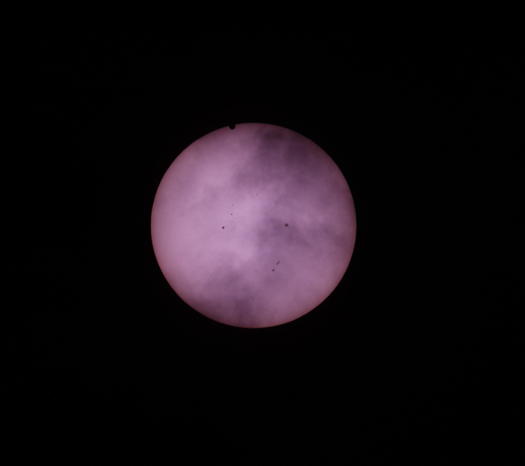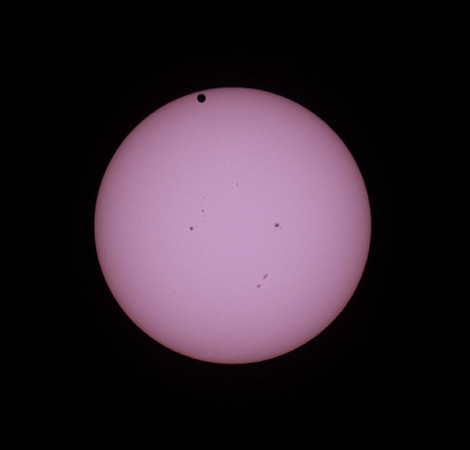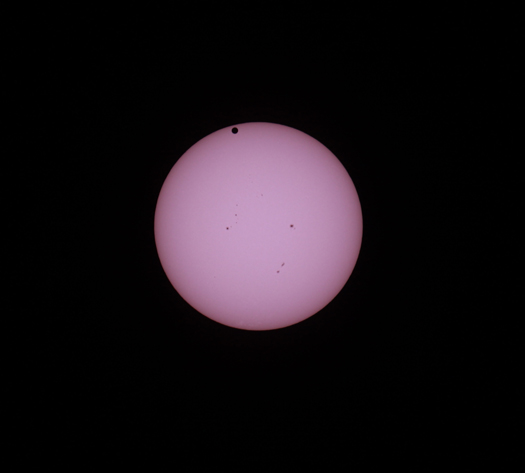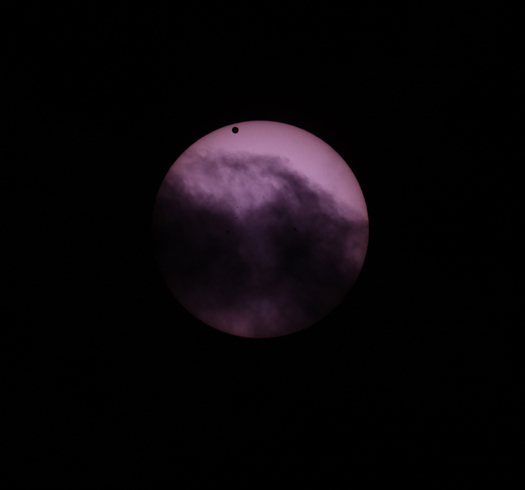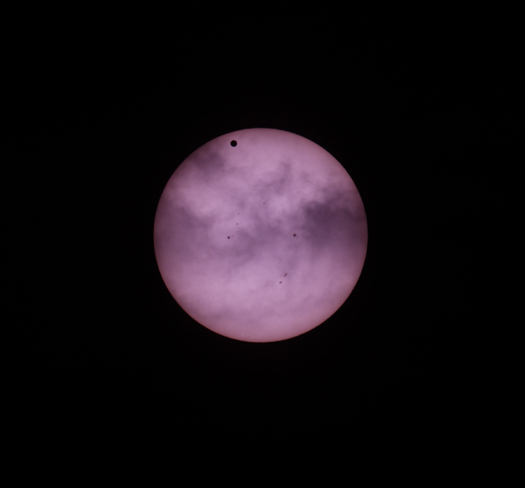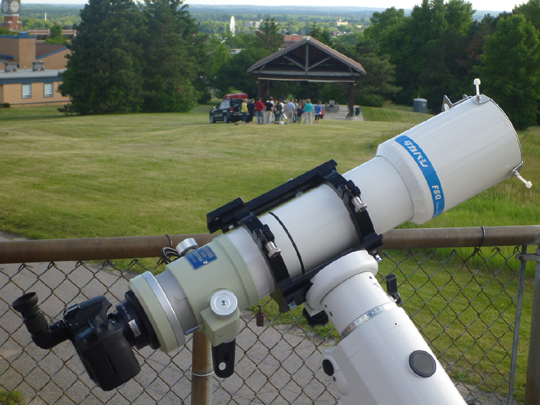The 2012 June 5-6 transit of Venus (ToV) is over, and there won't be another one till 2117! Many RASC members successfully viewed the ToV here and abroad, and you can find the graphic record of the observations―and of the astronomers making them―here.
Note: all images are copyright of the attributed photographers and graphic artists, and must not be used without prior permission
|
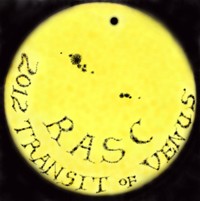 |
Barry Matthews, Ottawa Centre
Well, for a change the gods forgot to cloud out an event at Inushuk observatory (my observatory in Ottawa). Cecilia and I hosted a Transit of Venus party, featuring views through my 5" Meade refractor for invited for neighbours, friends, and my observatory "Patron" (retired navy admiral's wife who I have cleared snow for a number of years, and who generously paid for a lot of of my observatory. Patronage worked for Galileo, so why not for me!). In total we had about 12 visitors plus a 10-month old boy (who might just see the next TofV in 2117), and a set of twins. Like Roy's comment about seeing the first slight notch, I too found the sight absolutely breath taking. I was at the scope and will never forget it. On of my visitors was waiting with me, and when I said out loud "it's starting," she said "don't say anything to the rest please - let me see it first!". From the on I had a steady stream of viewers for about 2 hours until trees blocked our view. At that time we went out to our front yard and tried to see Venus on the Sun through the Dunlap Institute-RASC transit of Venus glasses. I guess my 70+ eyes where too old, but several of the younger guests where able to see Venus. In all it was a great success, and the party went on until the youngsters had to hit the sack.The most interesting comment I heard was "YOUR KIDDING ME - ARE WE REALLY SEEING THE PLANET VENUS? AND WHY DOES IT PASS IN FRONT OF THE SUN" (this from a retired civil servant). He later asked if he could come over and see other planets (- but of course!). I missed the last transit much to my disgust, as I was repairing microscopes in Northern Ontario.
Tony Peterson, Ottawa Centre
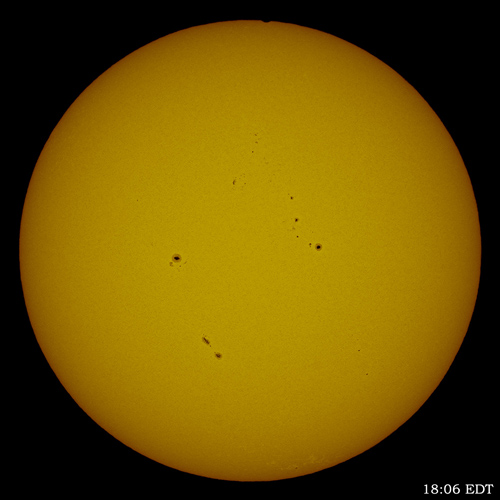
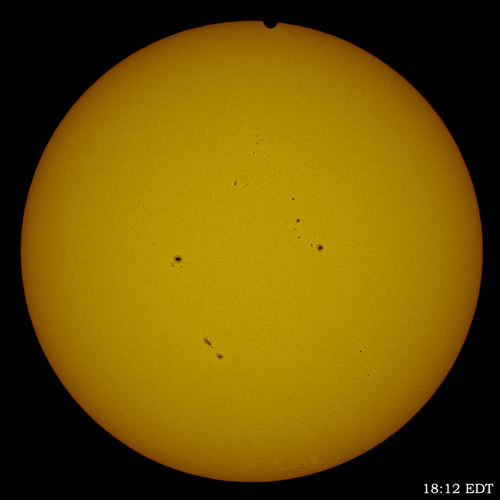



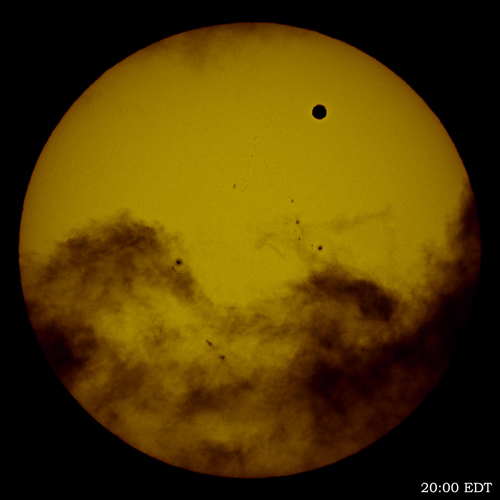
Tony writes:
Might this have been the most-photographed sky spectacle in history?
Imaged south of Foymount, Ontario; modified Canon 50D on TV-85 + 2x Powermate (f/14), with Baader solar filter. Shutter speeds varying from 1/400 s to 1/160 s.
More of Tony's spectcular astrophotography can be seen here.
Robert Dick, Ottawa Centre
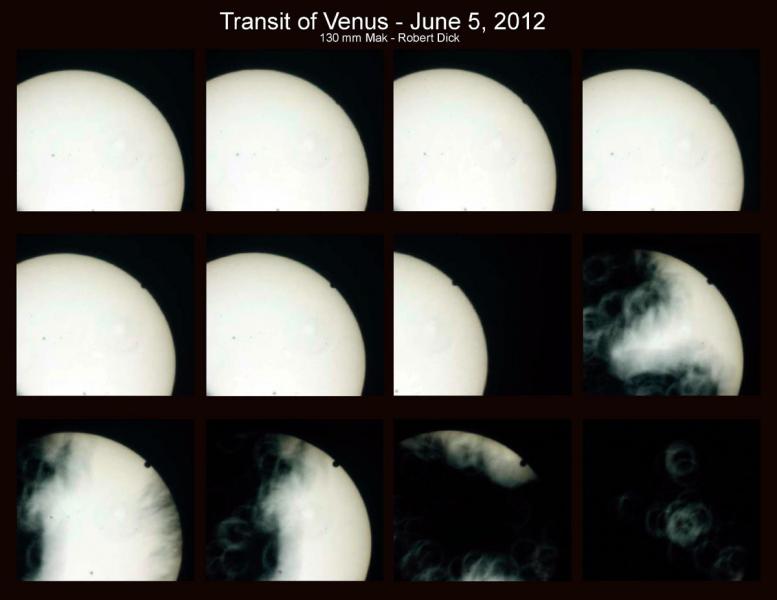
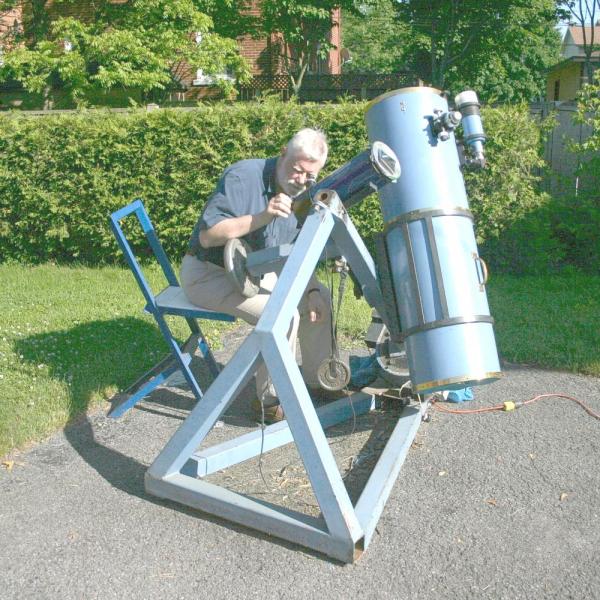
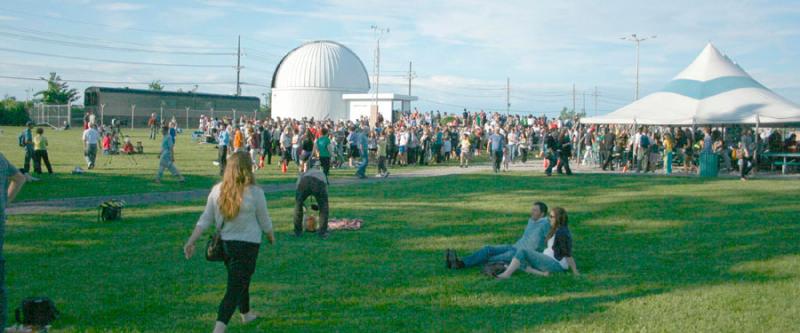
Rob writes:
My son Jonathan was at his after-school job until 5:30 pm. So we were to watch it together when he got home. If it was cloudy in Ottawa, my plan was to go to my Observatory at Rideau Ferry Ontario, about an hour south of the city. The clouds were moving towards the SW and this would give us extra relatively clear sky. As it turned out, it was clear in Ottawa.
I prepared in Ottawa by attaching a 130mm Maksutov telescope to my mount that usually carries my 12.5” f/4 telescope. My old solar filter material was not suitable for this event, so I kludged a filter out of some other materials that were left over from a number of different projects. I planned to photograph the event and look at the transit without a telescope – using only #14 welder’s glass, which I keep on hand for monitoring naked-eye sunspots.
There were pinholes and scratches in my filter concoction that produced a not-very-sharp and somewhat overly bright image. In order to reduce the brightness of the Sun with my homemade filter, I had to stop the telescope down from about 5" to about 3". I think this long focal ratio, and resulting depth of field, put every bit of dust and dirt into focus. The up-side was that I could use a fast shutter speed.
Although it was quite clear – there was a tree. It was a very large maple tree that usually would be to the side of the Sun. Except on this day. There was a strong breeze that pushed the branches over to the side.
At first contact the Sun was higher than one particularly tall branch, but about half way to second contact the Sun had set low enough to be occulted by the leaves.
So, we missed second contact. To experience the event with others, Jonathan and I drove across the city to the CMST to join the 2,000+ people who were there for the event.
It was great gathering with line-ups to telescopes over 100-long. Just above the western horizon was a band of cloud that was due to arrive at the end of the day. The cloud covered the low Sun a bit before 8 pm, but then the Sun poked out under a break in the cloud bank for an encore.
The sky conveniently clouded up for good after Venus passed below the distant bush line. Then it began to pour rain – really hard, but gave most telescope owners a few minutes to cover up their gear!
I rate this transit as more memorable than the morning transit a few years ago. This one was late in the day so I was more awake than before, I was able to share it with my son, and he was old enough to comment on it. And of course it was the public crowd rather than just a bunch of astro-geeks.
Kim Hay, Kingston Centre
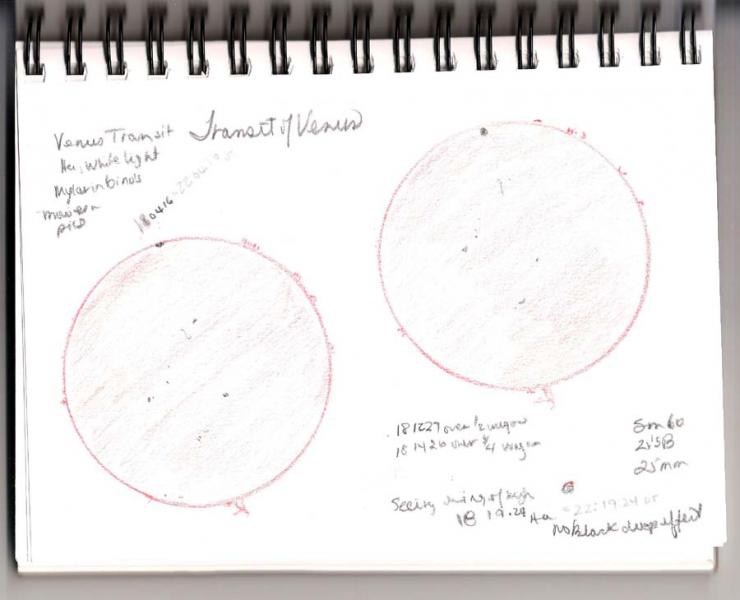
Rick Stankiewicz, Peterborough (unattached)
Images taken with a Canon 50D, Takahashi FSQ-106, EQ6 mount, and Kenrick solar filter (ISO 100; 1/2000 to 1/2500 sec.), and Nikon Coolpix 4500, Meade ETX90 and Thousand Oaks filter (ISO 100; 1/30 to 1/60 sec.; f/3.5; some cropping)
Rick writes:
June 5th 2012 will go down as a rare event indeed in the annals of this unattached member of the RASC. On Armour Hill, in Ashburnham Memorial Park, Peterborough, Ontario, there were a total of five telescopes equipped for solar viewing, sets of binoculars, numerous welders glasses―and “eclipse shades”, too. There were at least a dozen members out from the local astronomy club (Peterborough Astronomical Association―PAA) to man their stations doing duty from traffic control to PR, answering questions, and running equipment.
What a great show of support for this huge event! The media and public were well-primed, and it showed with the hundreds that showed up, lined up, and looked up at what was a once in a lifetime event for most of them.
On all fronts and by all accounts this event was the biggest and best the PAA has ever mounted. The media, the members and the public were all on side. Only the weather didn’t fully cooperate, but the clouds didn’t prevent the crowds from showing up, taking their chances, and being wowed! The clouds prevented seeing anything for most of the 3-hour window we were to have, but the start of the transit was definitely better than the end (when it rained on us), as the images show. The clouds actually added some depth and another dimension to some of the images―I like the “smoky” quality it gave.
The “planet and star” aligned for this one, and we are all happy they did because few if any of those in attendance (including the babes in arms) will be around in 105.5 years to see the next transit in December of 2117.
I know that there are a few members, like me, that feel doubly blessed to have witnessed two Venus transits in our lifetimes. What a difference eight years made in the technological changes to our hobby.
Kept looking up!
Randy Boddam, Belleville Centre
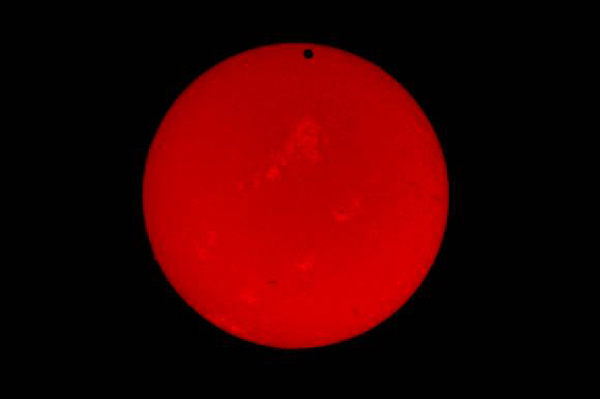
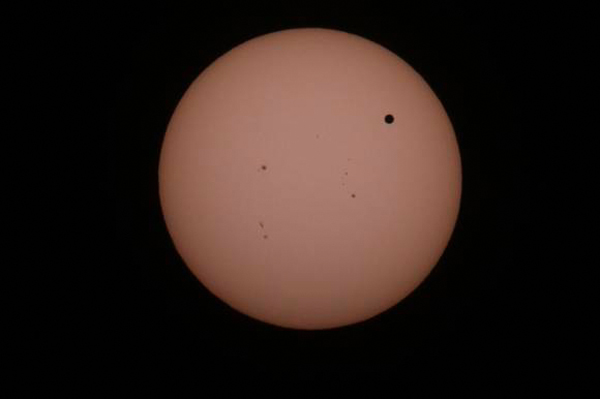
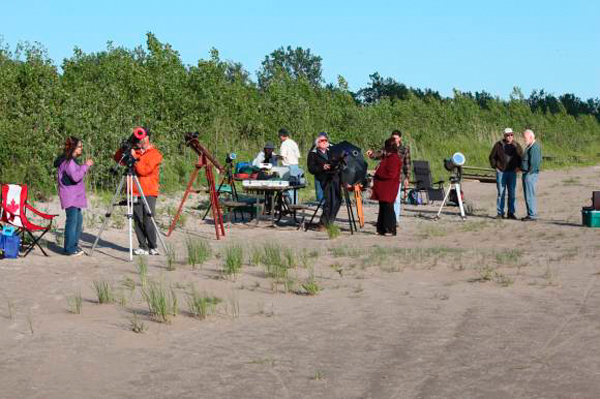
transit in hydrogen-α by Greg Lisk; white-light transit by David Cotterell; white-light transit by Randy Boddam; Bellville Centre members and guests by Greg Lisk
Randy writes:
Belleville Centre conducted two observing sessions of the Transit of Venus. The principle session was conducted at Presqu'ile Provincial Park in Brighton, Ontario. This site was chosen for its location as a point projecting into Lake Ontario from it's northern shore allowing us just that little bit of extra time before the sun dipped below the horizon. Sadly the weather was not as cooperative as in some other locations across the country. We had 10 Belleville Centre members accompanied by 3 spouses observing from first contact until about a half an hour before sunset (when the clouds moved in). A half dozen "happy campers" also participated.
One member, because of work committments, couldn't be in Brighton, and so a satellite observing session was held in Petawawa, Ontario, two hours NNW of Ottawa in the Upper Ottawa Valley. Sadly this event was plagued by clouds. There was a brief glimpse just after first contact, and then the Sun appeared again for 20 minutes about 45 minutes before sunset. A filtered white light picture by Randy Boddam is also included (pic 4). There were three other participants at that site.
Although fewer clouds would have buoyed spirits more, the event was a huge success in both settings.
- Log in to post comments

